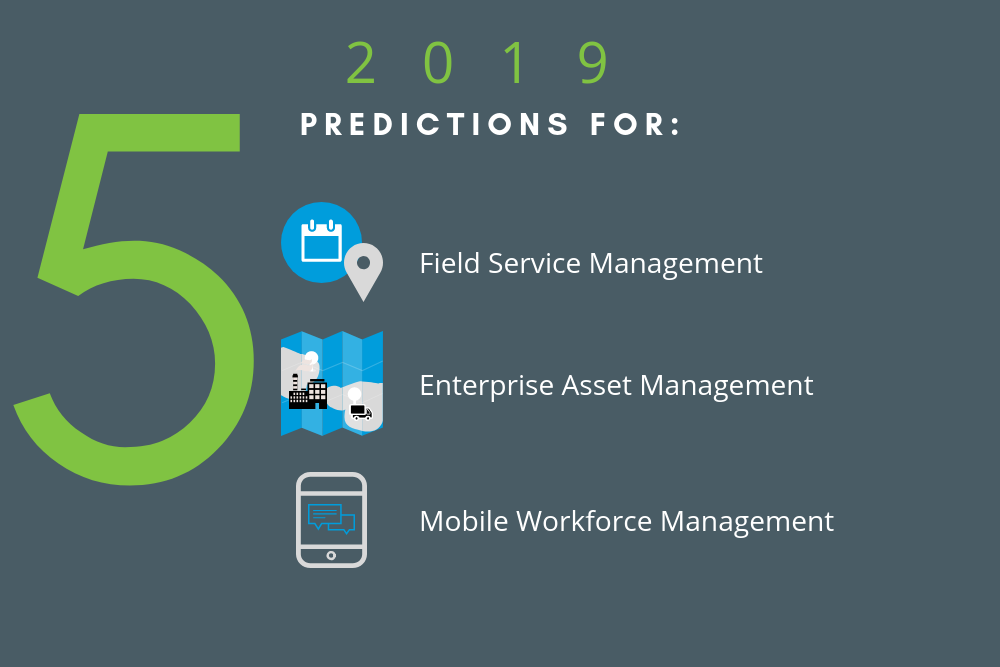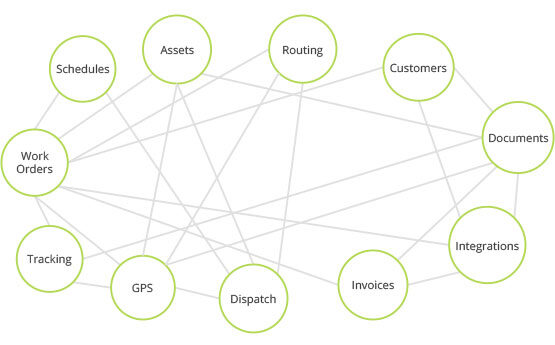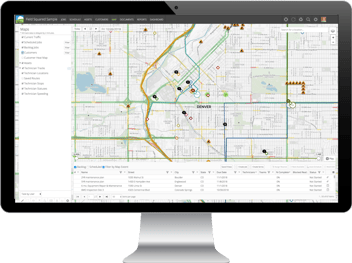
With 2018 just behind us, this past year was a turning point for field service, enterprise asset management, and mobile workforce management. In June of 2018, I penned a blog post detailing 5 key field service management trends to watch in 2018. Looking back, it was evident my forecast for two of the five trends hit-home, with the top trend of innovating the customer service experience gaining momentum in 2018. Of course, in the Age of the Customer, it wasn’t a stretch to see that particular trend come to the forefront.
Over 2018, I had many conversations with customers where I could clearly see new points of discussion taking precedence. In this post, I will cover 5 field service, enterprise asset management and mobile workforce management predictions for 2019.
#1: Increasing Adoption of Geospatial Enterprise Asset Management, Coupled with Field Service Management Solutions
It’s common within field service organizations to track, manage and monitor internal or customer assets (i.e., property, plant, equipment, inventory, fleets) and oftentimes both. Organizations that also require solutions for mobile workforce management fit this category as well.
Increasingly we hear from organizations that want to adopt cloud-based field service management software, but that also need mobile enterprise asset management software in a single solution. In order to effectively manage their distributed assets, they seek an end-to-end automation solution that enables them to do several key things:
- Maintain an accurate geospatial registry of enterprise assets
- Geofence mobile assets
- Scan barcodes, RFID tags or QR codes
- Conduct preventative asset maintenance, inspections, work order creation and scheduling
- Remotely monitor assets
- Connect with their IoT solutions
- Leverage third-party analytics tools such as Tableau, SAS, Hortonworks, Tibco or OSIsoft PI System
- Seamless integrations with their existing back-office systems, including ERP, GIS providers like Esri, inventory management tools, MRP and MROs, and financial tools
What I’m hearing is it’s not just the ability to manage assets that’s important, rather, how. Here at Field Squared, we built our enterprise asset management module on top of a proprietary, native geospatial information system (GIS). Managing and servicing enterprise assets, then, is significantly easier when you can leverage the time and space of assets. From this invaluable spatial data, organizations can track the location of assets over time, geofence assets, determine which assets utilize the most resources to maintain and so much more.
Whether managing internal or customer assets, there is tremendous unrealized value for field service organizations to enable business process automation and orchestration from the office to the field, and across back-office systems, to reap cost savings and efficiency gains. Over 2019, I expect the trend in adopting field service and enterprise asset management in a single, unified solution to gain momentum.
#2: Real-Time In-App Collaboration for Field Service and Mobile Workforce Management
The world as we know it is real-time, bolstered by the right technology to make it happen. When it comes to field service and mobile workforce management, every second lost is a work order delayed, a dissatisfied customer made and an enterprise asset overdue for maintenance.
What’s the answer? Real-time collaboration and messaging tools embedded in the field service management app you use every day. The key here is providing your field workforce with one app from which to manage their work. Not two or three or four, one app. We saw this need go unmet, so this year we partnered with Nexmo, the Vonage API company, to bring this feature and embed it into Field Squared.

The next year will see increasing demand for this type of solution. Luckily, if you want it right now, Field Squared is the industry’s first such solution. Contact us for a test drive.
#3: Partial to Full Automation of complex field workflows and processes
Since I co-founded Field Squared, it was evident enterprise field service organizations were just beginning to adopt cloud-based business process automation. The idea that you can take many discrete field service processes—those highly redundant, error-prone and repetitive tasks—and partially or fully automate them, is a novel idea and one we find to be exceptionally compelling in the world of field service, enterprise asset and mobile workforce management.
I know you’re thinking it seems ludicrous to give a system the control to send automated status updates, push notifications or talk bi-directionally with back-office systems, and we understand the trepidation. With all humility, today that line of thinking belies the fundamental goal of increasing operational efficiency as well as reducing costs. With the right field service management automation software, building automated workflows is not only intuitive, it will become a requirement in the very near future.
Given my experience this year in seeing more customers create automated workflows across their environments, I know 2019 will see a rapid acceleration to implement automated field service business process workflows. I recommend reading the article, 7 Field Service Processes and Workflows to Automate Today, I wrote for in Field Technologies Online, if you’re looking for additional insight around the power of field service automation.
#4: Leveraging a Field Service, Enterprise Asset and Mobile Workforce Management Platform as the Single Source of Truth
Many field service organizations are looking to move away from using multiple applications and tools to complete a work order, conduct asset maintenance or digitize their work order forms. What they want is one solution to rule them all. A single solution for their field service management, enterprise asset management and mobile workforce management needs all wrapped up in a single pane of glass. And it is a reality. That’s why Field Squared exists.
Most solutions on the market can only handle one or maybe two aspects of the aforementioned request. But there does exist a unicorn among the crowd (Field Squared, of course) that provides a solution where the actual software can be the single source of truth, if you want it to be. In order to adopt the right technology, it must be capable of meeting the following needs, which we’ve gathered over many customer calls:
- Extensible across third-party back-office systems, including home-grown and custom applications, via integration (i.e., API, web services, SFTP)
- Allow for partial to full automation of field service business processes and workflows
- Contain an enterprise asset management module that allows for work order creation, scheduling, and monitoring of internal and customer assets
- Mobile application for the field workforce that is intuitive and requires very few clicks to complete work orders
- Granular team and role-based security access
- Correlate GPS location data, mileage and time-on-site with any activity
Here’s a visual representation of how Field Squared is the single source of truth:

And that’s where 2019 is headed. Many will try to emulate this, but few will actually achieve it. We’ve been building or enhancing Field Squared since the beginning to meet all of these needs, so it’s not an overnight project for other solution providers in this space. Field Squared is already tried, tested and in use at many Fortune 500 and 1000 customers.
#5: Leading Edge Technologies on the Rise for Field Service Management
Our 2019 field service management predictions would not be complete without mentioning some of the leading-edge technology I see as having more of an impact over the next year.
The coming of age for business adoption of augmented reality (AR) and virtual reality (VR) is upon us. If 2018 was the introduction of what can be, then 2019 will see the actual adoption of what is. There was much talk over the past year about the use of mixed reality in the field service and enterprise asset management space. In fact, the topic came up so frequently, we blogged about it in How Augmented Reality Will Change Field Service Operations. The premise for AR in field service and asset management is overlaying key contextual information, as well as detailed schematic data, on the field of view in such a way that allows the field technician to repair an asset or equipment more efficiently. The result is increasing operational efficiency and decreasing repeat visits.
While the Internet of Things (IoT) will take significantly more time to adopt at the average small to mid-size field service business, I expect 2019 will be an area of growth across large to enterprise organizations. This mainly has to do with the application of IoT in such industries as Oil & Gas, Telecommunications and Manufacturing. In these asset-intensive industries, sensors have been added to practically everything to allow for remote monitoring and proactive response to issues that arise. Earlier in 2018, I also blogged about on the topic of IoT in, The Promise of an Interconnected World: The Impact and Challenges of IoT on Field Service Organizations. If you haven’t had a chance to read the post, it provides a few examples of the positive impact while taking into account two main challenges or barriers that some field service organizations may experience as they seek to adopt IoT solutions.
All in all, 2018 was a fantastic year for new, exciting developments across field service, enterprise asset management and mobile workforce management. Part of that comes from a palpable buzz in the space right now, but another part comes from announcements Field Squared has made over the year. We can’t wait to ring in 2019 to share additional industry-first innovations with our customers and partners. Stay tuned.



